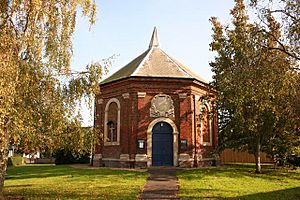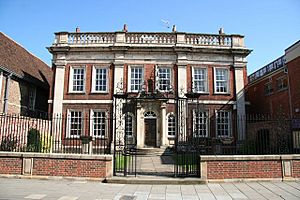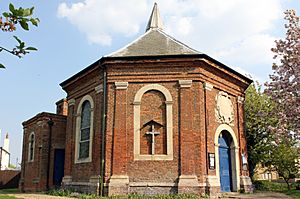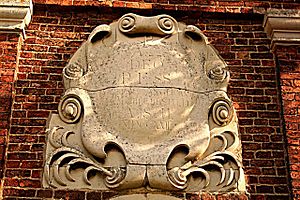William Sands, senior facts for kids
William Sands, senior (who died in 1751) was an English architect and mason. He worked in the town of Spalding, in Lincolnshire, England.
William Sands was a leader in a group called the Freemason's Lodge. He was also a member of the Spalding Gentlemen's Society. This was a group of important people who met to discuss interesting topics. Sands was known for creating building plans for others to construct. He also made monuments, like gravestones. You can see examples of his work at Croyland Abbey and the church in Weston. His son, William Sands, junior, later continued his father's work.
Contents
Buildings Designed by William Sands
William Sands was a talented architect. Here are some of the buildings he is believed to have worked on.
Fydell House: A Mystery Building
Fydell House is an old building in Boston, England. It was built in the early 1700s. Some experts, like Nikolaus Pevsner, thought William Sands designed it. Before that, people thought another architect named Henry Bell built it.
Pevsner believed Fydell House was built around 1726. This was 15 years after Henry Bell had died. So, Pevsner thought Bell could not have been the architect. However, newer research suggests the house might have been built before 1704. If so, Henry Bell could have designed it after all.
The idea that Sands designed Fydell House comes from its look. It has features similar to Moulton Chapel, which Sands designed in 1722. Both buildings have large, decorative columns called Doric order pilasters. They also seem to be inspired by Dutch brick architecture from the early 1700s.
Moulton Chapel: A Unique Church
St James' church in Moulton Chapel is a special building. It was originally built with bricks and has an unusual eight-sided shape. Each side of the octagon has two large Doric order pilasters. These are like the ones seen on Fydell House.
The church's doors and windows are arched. Inside, the roof is shaped like a dome. There is also a decorative stone with the date 1722 carved into it. The Spalding Gentlemen's Society has a drawing by John Talman. This drawing shows that Sands originally planned to add a small dome, called a cupola, on top of the church.
This church can be compared to the Octagon Chapel in Norwich. That chapel was built in 1756. It is thought to have been inspired by similar Dutch buildings.
Monks Hall: A Farmhouse Project
Monks Hall is a farmhouse located in Gosberton, Lincolnshire. It was built in 1729. William Sands provided the plans for this house. A carpenter named John Proudlove then built it.
The farmhouse has been changed quite a bit over the years. Most of the changes happened in the mid-to-late 1800s. It originally had two stories and a front with three sections. The roof was made of slate. Inside, some of the original roof timbers are still there. The area around the house is surrounded by a moat, which is a deep, wide ditch. This site was once a small religious house in the 900s.
Burton Pedwardine: Unbuilt Plans
William Sands also drew up plans for a new large house in Burton Pedwardine, Lincolnshire. However, these plans were never actually built.
Further Reading
- Pevsner, Nikolaus; Harris, John; Antram, Nicholas (1989). Lincolnshire. Yale University Press.
- Colvin, Howard (2008). A Biographical Dictionary of British Architects, 1600-1840. Yale University Press.





